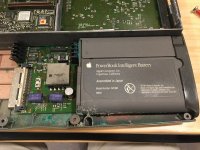Hi,
I noticed I couldn't take out the battery in my 540c, so I took apart the case and found that the main battery had leaked pretty badly in the bay. I'm wondering if there is a way to clean up the corrosion and and stuff. Searching around I found articles and tutorials for alkaline batteries, but nothing specific for Ni-MH (actually most sites said it was very rare for Ni-MH batteries to leak badly). I found an article from Energizer (https://data.energizer.com/pdfs/nickelmetalhydride_appman.pdf) stating that the crystals are potassium carbonate, so perhaps a weak acid, like vinegar could clean it up? Some of the crystal build up looks green, my guess is that was corrosion from the copper leads?
Any tips for cleanup would be appreciated!
Thanks

I noticed I couldn't take out the battery in my 540c, so I took apart the case and found that the main battery had leaked pretty badly in the bay. I'm wondering if there is a way to clean up the corrosion and and stuff. Searching around I found articles and tutorials for alkaline batteries, but nothing specific for Ni-MH (actually most sites said it was very rare for Ni-MH batteries to leak badly). I found an article from Energizer (https://data.energizer.com/pdfs/nickelmetalhydride_appman.pdf) stating that the crystals are potassium carbonate, so perhaps a weak acid, like vinegar could clean it up? Some of the crystal build up looks green, my guess is that was corrosion from the copper leads?
Any tips for cleanup would be appreciated!
Thanks

